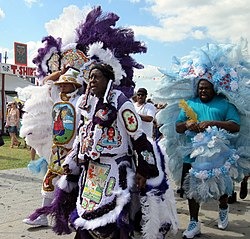Empowering young girls through heritage, creativity, and the resilience of Black Masking culture.

Girls Like Me Project participants explore Black Masking culture in New Orleans, learning about heritage, resilience, and sisterhood. Photo by Kianga J. Moore
This summer Girls Like Me Project founder LaKeisha Gray‑Sewell reflected on a 2022 trip where she and her mentees travelled to New Orleans to experience “Black Masking” culture. As the nation marks Indigenous Peoples Day, the identity discussion feels urgent. As we slip back to recognizing Columbus Day- this moment invites us to ask who gets to tell history. Gray‑Sewell’s answer is simple: “we tell it ourselves.”
Girls Like Me began as lunchtime sessions where Gray‑Sewell envoutaged nine‑year‑olds to look beyond reality‑TV stereotypes. The gathering grew into a non‑profit that teaches media literacy and storytelling To youth. “Media saved me,” Gray-Sewell said. “We want our girls to disrupt stereotypes and adopt sisterhood.”
That mission found expression in New Orleans. Black Masking culture – often called Mardi Gras Indians – dates to the 1800s, when Native Americans sheltered runaway slaves. Excluded from white Mardi Gras krewes, Black residents created their own Carnival, sewing thousands of beads and feathers into suits that tell stories of freedom.


New Orleans Black Masking Indian Tradition
Tribes are hierarchical, with roles like Big Chief and Big Queen and suits that take a year to sew. Call‑and‑response chants and handheld percussion bind the parades together as tribes vie for the “prettiest” suit.
The girls immersed themselves in tradition and stories that spoke to indigenous identities. Queens who lead the Washitaw tribe’s masking and director of African American dance at Tulane University — along with gallery owner Bernadine Gilsman spent hours sharing their experience.
They explained how Congo Square served as a sanctuary for African drumming, why New Orleans passed tignon laws regulating Black women’s head coverings, and how masking helped hold communities together after Hurricane Katrina. Some girls wept as they learned how enslaved ancestors hid rice and other seeds in their hair to survive the Middle Passage- others were inspired by watching Black women lead and preserve the city’s heritage.
Gray‑Sewell offered insights about claims that Black people were here before colonization, “It’s layered. Our job isn’t to prove or disprove. Wherever we show up, we belong,” she said. Her philosophy mirrors Muscogee activist Amber Starks, who writes that Afro‑Indigenous identities are diverse and not monolithic.
Since returning, the girls have screened mini‑documentaries and organised second‑line parades in Chicago. Gray‑Sewell sees the journey as a turning point. The girls learned that heritage and creativity can interrupt violence and that sisterhood doesn’t stop at a city border. On Indigenous Peoples Day embrace the beauty and resilience of courageous people who carry their ancestors like the wind.
#BlackMaskingCulture #GirlsLikeMeProject #IndigenousPeoplesDay


